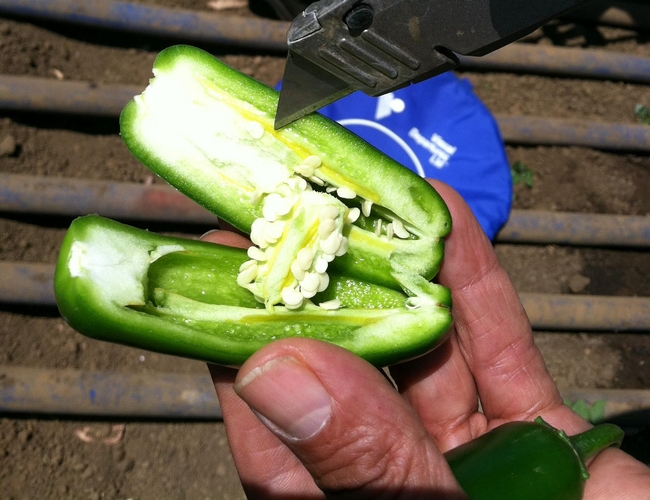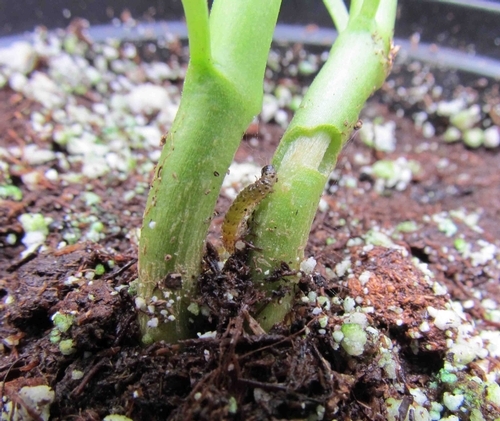Posts Tagged: pepper
Reporter ponders UC Cooperative Extension pepper research
A column in the Salinas Californian playfully reflected on UC Cooperative Extension research that aims to turn up the heat in the mighty jalapeño pepper.
Writer Dennis Taylor reported that Aziz Baameur, UCCE farm advisor in Santa Clara and San Benito counties, is trying to increase the Scoville units in hot peppers by adjusting on-farm practices.
"The trend lately is toward hotter items," said Jeff Sanders of George Chiala Farms in Morgan Hill, the site of the research project.
Taylor waxes on about super hot peppers that are being grown around the world - including the current record holder, according to Guinness, the Carolina Reaper, which is 900 times hotter than the jalapeño.
He wrote that he asked a newsroom colleague, UCCE Master Gardener Laramie Trevino, whether she would prefer more heat in jalapeños, and he mentioned a plan to call Baameur and Sanders to learn more about the motives behind their research work.
For more information about the hot pepper research, see: Some like it hotter: UC Cooperative Extension tries to grow a spicier jalapeño.
Indiana Jones of Gardening
Call me the Indiana Jones of gardening, but I wanted some adventure from my summer garden. I wanted to discover something “new” that was old (I hear that line from the movie ringing in my head, “It belongs in a museum!”). Among our adventures were the following:
The Heirloom Sweet Chocolate Pepper. This is a brown-skinned pepper at maturity, which starts out green, and is supposedly red fleshed on the inside (kind of like those glowing stones from the “Temple of Doom”). It is said to taste sweeter than the average bell pepper. Of course, it’ll add color to any salad and one review I read said it freezes well for winter use. You’ll see a picture of my plant below of a mature brown one and a “newbie” green one behind it.
The Psidium 'Lemon Yellow', or Lemon Guava was another adventure. Maybe you’ve heard of the Strawberry Guava Tree, well here is its cousin. Like Indiana in “The Last Crusade” looking for a golden statue, these yellow treasures make their trip from South America too. The little fruits are prolific on it, and I think we were just waiting for a bit more sun and warm weather to ripen them up so we’ll be able to reap our golden reward. We have it in a container and everything I’ve read says it’ll be fine there for quite a while.
Another veggie that I discovered was Black Spanish Radish. I found the seed packet hidden in a huge seed display at a local discount store. As you’ll see by the picture these didn’t get too big. The packet didn’t exactly “map out” any details, so I planted them like any other radish. As I’ve recently found out though, they are a winter variety and that could attribute to them not reaching their potential. They are definitely black though. That isn’t mud you’re seeing, that is the skin color! Well, the only “Jones” reference here is that apparently, they have been used medicinally by other cultures for thousands of years, and we all know Indiana was always eating or drinking some kind of concoction to cure something or protect him from something. I don’t know what they’d cure, but the ones that came from our garden sure have a “bite” to them! They start out with a regular radish flavor, and the heat builds from there.
So join me on an adventure in the garden this summer. It might be a little more relaxed than running from gigantic boulders or dodging poison-tipped arrows, but at least we get to wear cool hats!

Sweet Chocolate Pepper. (photos by Patti Brantley)

Spanish Black Radish.
Cooling cattle; European pepper moth examined
For an article "Should Wyoming livestock and ag adjust to climate?" in the Billings Gazette, reporter Paul Murray sought information about livestock animals' response to warmer temperatures from Frank Mitloehner, UC Cooperative Extension Specialist in the Department of Animal Science at UC Davis. Mitloehner talked about ways animals can cool down and discussed shade, fans, sprinklers and even alternative cattle breeds. "We're seeing more and more extreme weather. That is a tendency we're seeing more and more often. That can stress animals. Similar to animals in the wild, that can impact animals' reproductive ability and their performance," he told the reporter.
European pepper moth widespread in California
Surendra Dara for Western Farm Press
Western Farm Press published this article about European pepper moth by Surendra Dara, UC Cooperative Extension farm advisor in Santa Barbara County. Dara explains that the European pepper moth has been reported in several central and southern California counties. The pest prefers to feed at the plant base of crops such as corn, peppers, tomatoes, squash, strawberries and some ornamental plants. Dara has been appointed to the national Technical Working Group for European pepper moth, along with UC Cooperative Extension colleagues James Bethke and Steve Tjosvold.
Dara also wrote about this pest and shared photos of it on the UC Strawberries and Vegetables blog.



